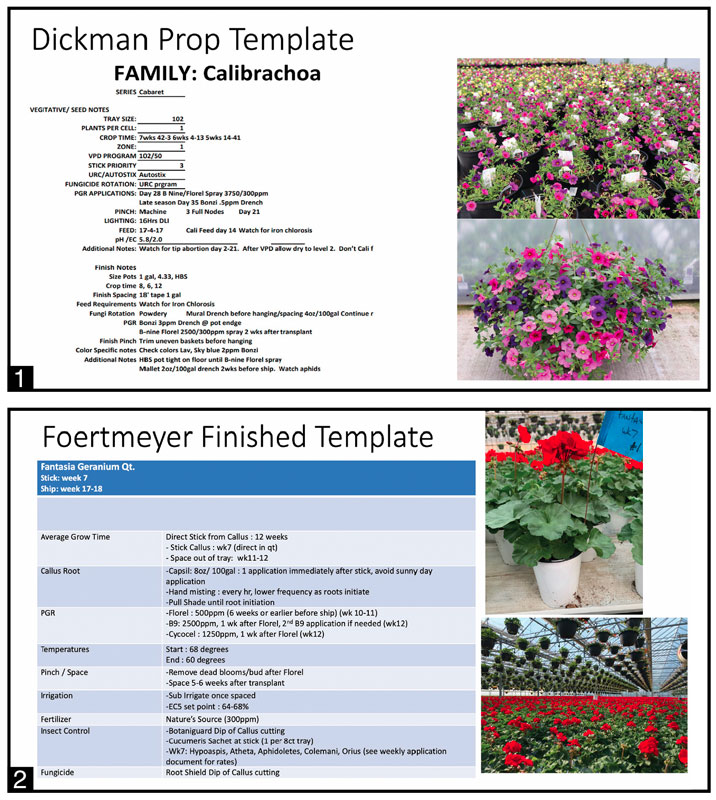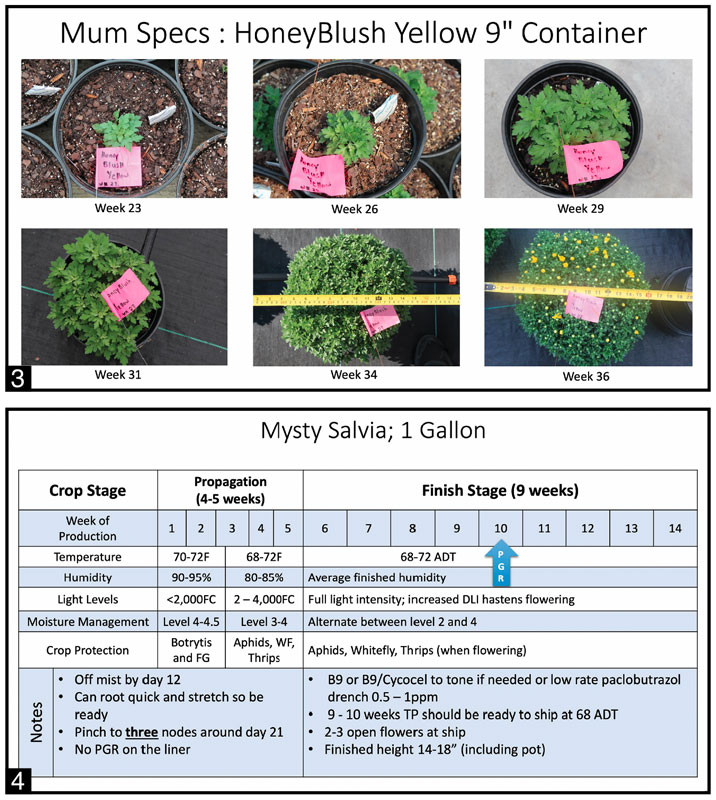10/1/2021
Measure to Improve
Bill Calkins
Cultivate’21 was not only a wonderful opportunity for our industry to get back to in-person events, friendships and networking, but also featured a strong educational component covering just about every aspect of horticulture. One session that was well-attended and well-reviewed because of its far-reaching implication on successful greenhouse production was titled “The Template Method for Growing: Case Studies in Maximizing Quality and Efficiency.”
Three speakers teamed up for this one and each brought a different perspective to the room, while agreeing on the importance of planning, documenting, tracking and staying consistent with each crop every season. Matt Foertmeyer (Foertmeyer & Sons Greenhouse, Ohio), Bob Dickman (Dickman Farms, New York) and Jason Twaddell (Ball Seed Company, Illinois) presented an eye-opening discussion about production planning that takes strategy to the next level. It was an exploration of how they build production templates that allow for strategic direction, data collection and improvement immediately and for subsequent years.
Developing a defined production template for every crop sets expectations and results in a guide for the entire team to follow. According to the presenters, it’s proactive versus reactive, allows you to hit tight sales windows and even tighter retail specs, reduces guesswork and improves training, and helps your group plan tasks by creating roadmaps. Having a clear template for all phases of every crop, saved digitally, includes creating visual and measured specs at each stage of production (propagation, vegetative growth, flower and finish).
This allows you and your team to plan tasks for each crop and leaves you with living documents that can evolve or grow with experiences year to year. Save these documents in a shared system like Microsoft OneDrive, Dropbox, Google Docs or whatever system you prefer, but be sure the files are easily accessible by the entire team via mobile use. Luckily, there are a ton of cloud-based file programs to choose from. Find the one that works best for your team and stick with it.
Most likely, you’ve been growing without detailed templates for years, maybe even decades. That’s okay. You can still grow great crops most of the time. But how do you train new growers efficiently? How do you improve each season or track improvement? These are the questions a template will answer. And here are the steps to implementing this method in your operation.
Defining expectations
The first step in building a template method in your greenhouse is to set expectations for each crop. The Cultivate speakers reminded the audience that you need something to aim at BEFORE you can hope to hit the target. This means you need to know and record what each plant needs to look like at each phase of production. Thankfully, these days, most of your growers will have a phone in their pocket with a great camera able to snap photos of the ideal spec. Once you have a folder of images, attach them (digitally) to your template file and you’ll always have a visual reminder of exactly what you’re aiming for.
Begin each crop with the end in mind. Your goal specs should include the photo mentioned above, clear measurements or metrics, and should cover each phase of production. Some examples shared by the speakers include ship week, height, width, number of blooms and percent in color.
Building schedules
Once you’ve laid out the expectations, it’s time to jump into your shared documents and start creating crop schedules for each key product. Start with your top crops and add to the library each season or year. This requires plenty of office time, which can be daunting, but it’s well worth the time and once the schedules are done, you won’t need to touch them very much moving forward.
One question that came up during the session was where exactly to find the production planning information to fill the templates? The presenters had a list of places to begin. First is your experience and the experience of your growing team. You have years of knowledge, so might as well get it down on paper. Expand out to your network of peers to get input. Then consider your breeding company partners or sales reps. Each one has a trove of knowledge from which to draw.
Beyond the people, our industry is loaded up with print and digital resources like product information guides, books, websites and, of course, trade magazines like GrowerTalks, that offer culture tips just about every issue. Digital and social media like Facebook and YouTube are becoming solid resources, as well, if you vet the source.

Creating templates (for each production phase)
Once you’ve gathered resources and started entering information on each crop, start breaking it all down by production phases. The speakers suggest propagation, vegetative growth and flowering/finishing. In your template for each phase, consider including:
• Approximate length in days
• Climate (soil/air temps, RH, light levels, air exchange)
• Flowering requirements
• Moisture management notes
• Fertility requirements
• Media pH/EC range
• Crop protection
• PGR strategy
During the session, the presenters each shared examples of the templates they use or have used in the past. Each was different, but included much of the same information. Matt talked about years of photos filed for each crop that the team at Foertmeyer can go back and reference.
Imagine having an organized source of photos showing an ideal crop week by week—the benefit that could have on your final crop quality is incredible. Check out some of the photos included with this article to see template examples. Solicit input from your team about how they want to see the information and you’ll have a much better chance of
implementation.
Review, revise, refresh
When working a strategy, one of the most important steps is to circle back immediately at the end of the process and evaluate successes and failures. Meet with your team at the end of each crop season and go over the method to find any breakdowns. And for each crop, identify any challenges and document them. Don’t allow too much time to pass before tackling this step because things move quickly in a greenhouse, and the next thing you know, you’ve forgotten quite a bit. It’s also better to have a 30-minute meeting after each crop ships versus an hours-long
meeting to go crop by crop. You and your team will appreciate it.
 The speakers ended the discussion with a few tips—first and foremost, keep it flexible. Your templates are playbooks and not marching orders. As a greenhouse “coach,” you start each crop with a game plan, but prepare to call plenty of audibles. But like a good coordinator, document these adjustments because they’ll no doubt come at you again.
The speakers ended the discussion with a few tips—first and foremost, keep it flexible. Your templates are playbooks and not marching orders. As a greenhouse “coach,” you start each crop with a game plan, but prepare to call plenty of audibles. But like a good coordinator, document these adjustments because they’ll no doubt come at you again.
Walk your crops. There’s absolutely no template in the world that takes the place of seeing and feeling your plants every day.
Finally, the presenters encouraged growers to “inspect what you expect.” If you directed your team to hit a certain spec, go out there and measure the plants, check the roots and bloom count, and determine if they were successful. If so, buy them a round of Gatorade. If not, have a quick, stand-up meeting to go over where the crops need to be. Before long, you’ll have a database of templates and a team that’s on the same page. Most importantly, your crops will ship on time and on point.
• Template 1: Dickman Farms uses a template for each key crop they propagate. Notice this calibrachoa template includes information on PGRs, pinching, pH/EC, specific issues to watch for and even notes on finishing the crop.
• Template 2: This finished geranium template from Foertmeyer & Sons covers the critical points in a straightforward way with photos. They have a clear target and all the info needed to stay on track.
• Template 3: Photos are a powerful way to show your production team where crops need to be from week to week. This look at 9-in. mum production covers 13 weeks visually.
• Template 4: Week by week, this production team knows when and what to do to keep these salvia on track. Check out the notes, added throughout the season for future reference and training.
In “The Template Method for Growing: Case Studies in Maximizing Quality and Efficiency” session at Cultivate’21, three growers shared the importance of having templates to follow for each crop at each stage. Here are some of their dos and don’ts to help with the process:
DO
• Save photos
• Keep notes
• Stay focused on what’s critical
• Look at new genetics as improvements
DON’T
• Guess
• Be too rigid
• Forget to review
• Forget to communicate with the team